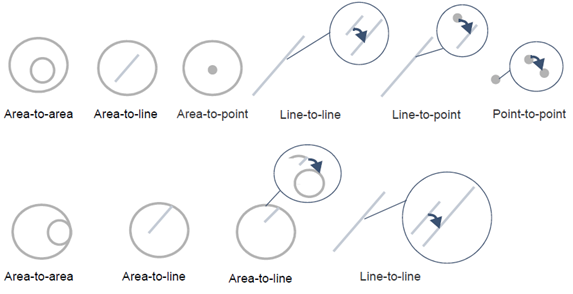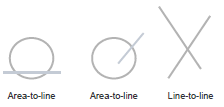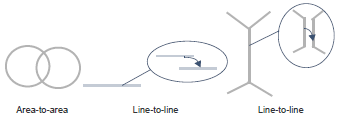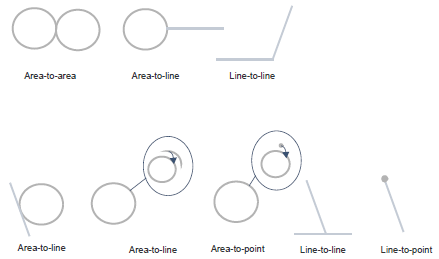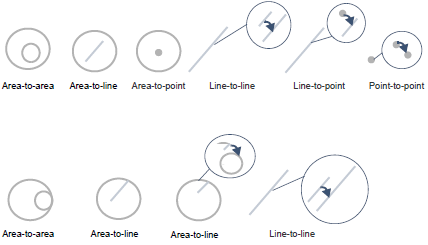




Relationships
A relationship compares any two values and returns a result of true or false.
They can either compare scalar values or spatial geometries.
Scalar Relationships
A scalar relationship compares any two values (boolean, integers, real numbers or literal strings).
The result is evaluated as true or false, returning true if the values have the specified relationship.
They may be familiar as mathematical constructs typically applied to numerical values, but can be used for many object attributes within 1Integrate.
| Scalar Relationship | Description |
|---|---|
| Equal |
The two values are the same. |
| Not Equal |
The two values are different. |
| Less Than |
The first value is less than the second value. |
| Less Than or Equal |
The first value is less than the second value, or the two values are the same. |
| Greater Than |
The first value is greater than the second value. |
| Greater Than or Equal |
The first value is greater than the second value, or the two values are the same. |
| Begins With |
For string values, test whether the first string begins with the second string. |
| Ends With | For string values, test whether the first string ends with the second string. |
| Contains | For string values, test whether the first string contains the second string. |
| Regular Expression | For string values, check whether the first string matches the wild card string or Perl regular expression in the second string. |
Spatial Relationships
A spatial relationship is a type of relationship only applied to geometry values. It returns true if the geometries have the specified relationship.
Any type of geometry can be passed into a spatial relationship check, but only the geometry types relevant to this spatial relationship will be tested. For example, if comparing areas, line geometries will not be tested.
Note: Some spatial relationships can be considered subsets of others. For example, Covered By is a subset of Within (if a geometry is Covered By another geometry, it is also Within that geometry).
The detailed description of each spatial relationship uses the terms interior, boundary, exterior. See Geometries for more information on these terms.
![]() Types of Spatial Relationships
Types of Spatial Relationships
| Spatial Relationship | Description |
|---|---|
| Beyond |
Beyond checks that at the closest point, two geometries are at least a specified distance apart (specified in dataset units). Note: Dataset units are decimal degrees for latitude/longitude. |
| Contains |
A geometry contains another geometry when one object's boundary and interior are inside another. The types of geometries that can contain another are:
Contains geometries Note: Contains is the reciprocal relationship to Within. |
| Covered By |
A Covered By relationship occurs when a geometry's boundary and interior are inside a containing geometry and the interiors of the geometries intersect. The types of geometries which can be covered by another are:
Note: Covered by is the reciprocal relationship to Covers. |
| Covers |
A geometry covers another geometry when one object's interior is inside another, and their boundaries intersect. The types of geometries which can cover another are:
Note: Covers is the reciprocal relationship to Covered By. |
| Cross |
Two geometries cross when a line runs across the boundary of an area, or the interior of another line. The types of geometries which can cross are:
Cross geometries |
| Disjoint |
A disjoint checks that two geometries are completely disjointed; neither the boundaries nor the interiors intersect. |
| Equal |
Two geometries are equal when they have the same interior, boundary and exterior. To be equal, geometries do not need to have the same number of vertices, and lines do not need to have the same direction. The types of geometries which can be equal are:
Equal geometries |
| Intersect |
Intersect checks that either the boundaries or interiors of the two geometries intersect in any way. The following relationships are checked to determine an intersect relationship:
|
| Overlap |
Two geometries overlap when two lines or two areas partly overlay each other. The types of geometries that can overlap are:
Overlap geometries Note: If two lines meet at 0-D (at the same height), the relationship is considered a Cross. |
| Touches |
Two geometries touch when one object's boundary meets the other's boundary or interior but the two interiors do not meet. The types of geometries that can touch are:
Touch geometries |
| Within |
A Within relationship occurs when a geometry's boundary and interior are inside a containing geometry and the interiors of the geometries meet. The types of geometries which can be within another are:
Within geometries Note: Within is the reciprocal relationship to Contains. |
| Within Distance |
Within Distance checks that at the closest point, two geometries are within a distance (specified in dataset units). Note: Dataset units are decimal degrees for latitude/longitude. |
